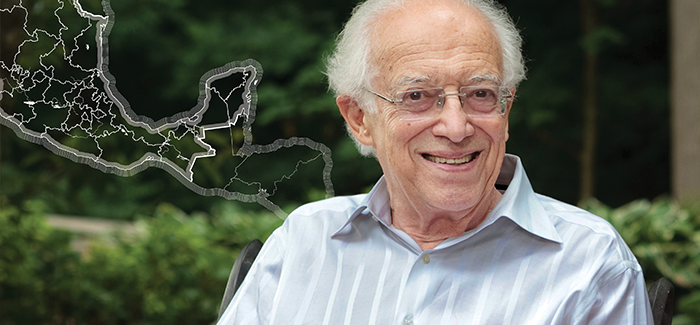
The government of Mexico awarded Friedrich Katz (seen above in 2000) the order of the Aztec Eagle, the highest award given to foreigners. (Photo courtesy the Katz Center for Mexican Studies)
UChicago honors its Latin American research roots.
When the International Reunion of Historians of Mexico was held in Querétaro in 2010, the event’s Mexican constituents named Friedrich Katz, the Morton D. Hull Distinguished Service Professor Emeritus of History, conference president. The honor, says history professor Emilio Kourí, was akin to declaring Katz an honorary Mexican citizen.
Katz, author of the seminal book The Life and Times of Pancho Villa (Stanford University Press, 1998), died shortly before the conference took place, but the legacy of his career lives on at the Katz Center for Mexican Studies, established in 2004. Katz not only studied Mexico but also empowered Mexican academics, says Kourí, “His love of Mexico was institutionalized at the University of Chicago.”
The conference, which meets every four years, was held at the University in September for the second time since 1981—the first time it’s repeated a US location—marking the Katz Center’s 10th anniversary. The University’s history of Latin American studies also was celebrated with a Special Collections Research Center exhibit, Researching Mexico: University of Chicago Field Explorations in Mexico, 1896–2014, which ran June 30–October 4. Cocurated by Seonaid Valiant, AM’01, CER’13, PhD’14 (History), and Kathleen Feeney, head of archives processing at the Special Collections Research Center, the exhibit included photographs, letters, and artifacts showing how historians like Katz and early anthropologists such as Frederick Starr; Robert Redfield, LAB 1915, PhB’20, JD’21, PhD’28 (Anthropology); and Norman McQuown helped establish the social sciences at the University and made UChicago a leader in Latin American studies.
These scholars’ pursuit of knowledge of Mexico was an international enterprise. More than at other institutions, Kourí says, “Chicago was spared the colonial gaze of the early anthropologists, although it wasn’t entirely absent.” Redfield became interested in Mexico after observing that many citizens had migrated to Chicago. He wanted to explore why, and how immigration changed their culture. He and other University scholars “really partnered with Mexicans,” Kourí says. “They were equals.” Kourí points to Alfonso Villa Rojas and Manuel Gamio, Mexican anthropologists who worked with UChicago researchers.
The center continues to pursue its mission of advancing research and promoting intellectual issues relating to Mexico, hosting Tinker visiting professors and senior faculty members from El Colegio de México, publishing works by UChicago history scholars and collaborators in Mexico, and sponsoring public lectures. As the University looks for new opportunities to expand its partnerships with Latin American institutions, Kourí says, the Division remains dedicated to “its commitment to engaging our international presence.”
[[{"type":"media","view_mode":"media_original","fid":"2145","attributes":{"alt":"","class":"media-image","height":"321","typeof":"foaf:Image","width":"460"}}]]
Robert Redfield, shown above with his family in Mexico, 1929, decided on a career in anthropology after his initial fieldwork in 1926. (Special Collections Research Center, University of Chicago Library)
[[{"type":"media","view_mode":"media_original","fid":"2144","attributes":{"alt":"","class":"media-image","height":"634","typeof":"foaf:Image","width":"460"}}]]
Frederick Starr, the first University professor to consider himself an anthropologist, had a custom bookplate designed that incorporated iconic spiritual and political images from Mexico. (Special Collections Research Center, University of Chicago Library)
[[{"type":"media","view_mode":"media_original","fid":"2146","attributes":{"alt":"","class":"media-image","height":"648","typeof":"foaf:Image","width":"460"}}]]
In 1916 Frederick Starr documented Mexican carnival participants. (Special Collections Research Center, University of Chicago Library)
[[{"type":"media","view_mode":"media_original","fid":"2147","attributes":{"alt":"","class":"media-image","height":"680","typeof":"foaf:Image","width":"460"}}]]
Anthropologist Robert Redfield collected mexican broadsheets called corridos (circa 1920) during his fieldwork there. (Special Collections Research Center, University of Chicago Library)
[[{"type":"media","view_mode":"media_original","fid":"2148","attributes":{"alt":"","class":"media-image","height":"420","typeof":"foaf:Image","width":"460"}}]]
Anthropologist Robert Redfield also kept a journal documenting his interviews of Mexicans in Chicago. (Special Collections Research Center, University of Chicago Library)
[[{"type":"media","view_mode":"media_original","fid":"2149","attributes":{"alt":"","class":"media-image","height":"234","typeof":"foaf:Image","width":"460"}}]]
Anthropologist and linguist Norman McQuown documented Mexican and Central American indigenous languages. This 1939 chart of Totonac grammar is among the materials he compiled as part of an educational project at Mexico City children’s homes. (Special Collections Research Center, University of Chicago Library)
